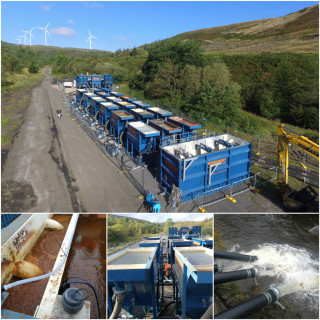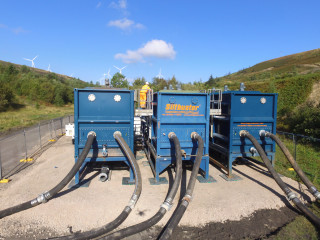When contractor JN Bentley was employed to carry out essential maintenance work at Castell Nos, a remote reservoir in the Welsh Valleys, one of its first tasks was to drain all the water.
This meant that, while the reservoir was out of commission, the client, Welsh Water, needed an alternative source of drinking water for its customers. Another reservoir, just a few miles away, was the obvious solution – but getting the water from there to the treatment works downstream was not a simple matter.
There was already an existing pipeline linking the alternative reservoir to the treatment works, but this had been decommissioned more than ten years previously and was itself in need of rehabilitation.
Before it could be used, the 15” (380mm) diameter iron water main needed a high-velocity pipe-flush to wash out any sediment that had accumulated over the years. JN Bentley’s engineers calculated that the 4,000m-long pipeline needed to be flushed at a flow rate of 750m3/hr for a minimum of six hours – and this needed to be done 10 times.
This huge volume of silt-laden water couldn’t simply be discharged into local watercourses and so JN Bentley needed some method of removing the sediment so that only clean water that met the requirements of Natural Resources Wales – the Welsh counterpart to England’s Environment Agency – was discharged into the local stream, the Rhondda Fach.
The contract for this part of the project was awarded to water treatment specialist Siltbuster, a leading innovator in on-site mobile water treatment. Siltbuster, based in Monmouth, is a familiar name in this part of south Wales, having carried out extensive treatment of silt-laden run-off for Costain on the A465 Heads of the Valleys road improvement contract just north of Castell Nos.
Each flush of the old water pipe would produce 4,560m3 of dirty water. “All that water had to go somewhere and the only realistic solution was to treat it on site and discharge clean water into the local stream,” says Siltbuster UK sales manager Tristan Hughes.
Prior to getting Siltbuster involved, the design teams at JN Bentley had considered other plans of action. The main factors influencing their final decision were the site’s remote rural location, sensitive environmental constraints and restricted access which included narrow country lanes through the neighbouring rural villages and towns.
Tankering was considered socially and environmentally unsustainable, primarily because of the implications of running more than 280 tankers into this remote area of Wales. On top of this, the cost of this type of off-site disposal was prohibitive, with each tanker estimated to cost around £1,000.
Another option – settlement lagoons – was also ruled out as they would have needed to be very large if they were to provide a sufficient and effective settlement area for the slow-settling solids. Open lagoons were also considered a safety risk given the public right of way that passes right through the site.
The only feasible solution therefore was a temporary water treatment works, and one on an exceptionally large scale. And according to Hughes Siltbuster was the only company that could provide a temporary water treatment solution capable of dealing with such a large volume of flush water at such a high flow rate.
The Siltbuster team designed the installation using equipment from the firm’s hire fleet, comprising three containerised dosing units, three 30m3 multistage reaction tanks, 18 HB50 clarifiers and a 30m3 sludge storage tank with associated pipework. The system is believed to be the UK’s largest-ever temporary modular water treatment system.
Time was of the essence and it was essential that the equipment was on site and working quickly: NRW imposed a strict time-frame on the works due to the imminent return of migratory salmon to spawn in the Rhondda Fach into which the treated water was to be discharged. “We had only four weeks,” says Hughes.
Despite the installation’s size and complexity, it took only 22 lorry movements to deliver the equipment, which was on site and operational in just two weeks.
“NRW’s regulatory position statement on the temporary dewatering of construction sites says ‘you shall not cause pollution’ – no ifs or buts,” says Hughes. Suspended solids had to be reduced to less than 60mg/litre, he explains. For comparison, river water is between 20 and 40mg/litre while drinking water must be below 10mg/litre.
“Our target here was 50mg/litre,” says Hughes.
The Siltbuster system works by filtering the incoming water and dosing it with chemicals that promote the precipitation of solid particles out of suspension. The solids then settle out and can be removed and the clean water discharged into the local water course.
Clay particles are very slow to settle out because of electronegative charges that cause them to repel each other, forcing them to stay in suspension. Siltbuster uses a coagulant to neutralise these electronegative forces and a polymer flocculent which promotes the clumping-together of the particles which can then settle out under gravity.

But no water – even after it’s been treated – can be discharged into the environment without an appropriate permit, in this case issued by NRW and obtained in advance by JN Bentley and its client, Welsh Water.
NRW no more wants coagulant and flocculent chemicals entering the natural environment than it does the silt they are used to treat. Therefore, the treatment process needs to be fine-tuned and monitored constantly.
“We have to balance the dosage with the amount of suspended solids carefully so that all the chemicals are removed along with the solid material that settles out,” explains Hughes.
Over the course of the ten consecutive pipe-flushes, the proportion of suspended solids in the water exiting the pipeline decreased until the water was flowing clean. Similarly, Stilbuster’s chemical dosage had to be adjusted so that only the quantity required to treat the incoming water (and no more) was added.
This was done with the help of Siltbuster’s Clarity data-logging app which monitors the treatment process and provides real-time alarm notifications either by SMS text messaging or email.
The app (which won a Digital Innovation Award at last year’s PlantWorx exhibition) monitors a variety of key parameters for both the inlet and discharge waters, including total suspended solids, pH, flow-rate, dissolved oxygen, conductivity and temperature.
Should any pre-set parameters be exceeded, the Clarity app will immediately notify staff via a simple ‘traffic light’ red-amber-green flagging system enabling them to take remedial action.
Operational data is recorded and can be extracted as a .csv file to provide detailed evidence of permit compliance, says Siltbuster.
According to Hughes, Castell Nos is a textbook example of how contaminated water should be treated on site; but he believes that many contractors even now are unaware of their responsibilities or negligent in their compliance.
“Some of them don’t even bother to obtain a permit – or they leave it too late,” he says.
Although there has always been a requirement for permits, the penalties until recently weren’t especially severe and failed to act as a deterrent. Contractors, weighing-up the cost of compliance against the risk of enforcement action by the relevant authority might choose to take that risk.
In 2014 more stringent penalties were introduced and fines are now based on a percentage of company turnover, says Hughes. One of the first offenders to feel the force of the new regime was the Balfour Beatty/Morrison/Carillion joint venture building the Aberdeen Western Peripheral Route which was slapped with a £280,000 ‘enforcement undertaking’ by Scottish Environmental Protection Agency in 2017.

Despite the more onerous penalties, contractors are still pretty slow on the uptake, says Hughes. “About 80% of our business is reactive,” he says. “We’re called in at the last minute by a contractor that’s found itself in a position where the Environment Agency is about to prosecute.
“They call us up in a panic hoping we can dig them out of a hole and I have to tell them that they have to get a permit first – because we can’t discharge treated water without the necessary permission,” adds Hughes.
Such a negligent approach at Castell Nos reservoir would undoubtedly have had serious consequences for Welsh Water and its contractor. Hughes hopes that the project will serve as an exemplar for other major contractors likely to be dealing with heavily silt-laden run-off.
For JN Bentley’s works manager James Ball, the solution provided by Siltbuster was “a dream come true. Everything it introduced worked better than expected, making our lives easier on site,” he says.
This article was first published in the April 2020 issue of The Construction Index Magazine
UK readers can have their own copy of the magazine, in real paper, posted through their letterbox each month by taking out an annual subscription. Click for details.
Got a story? Email news@theconstructionindex.co.uk



